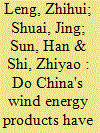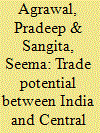| Srl | Item |
| 1 |
ID:
171370


|
|
|
|
|
| Summary/Abstract |
China has become the leader in the wind energy industry and the “Belt and Road Initiative” provides a broad stage for China's international cooperation in this field. This paper examines the trade status of China's wind energy products in the “Belt and Road” countries, and measures the export potential and its determinants in the market of these countries, by adopting the gravity model with a balanced dataset of 19 products and 65 countries covering the period 2007–2017. The results indicate that: (1) China's wind energy product trade with the “Belt and Road” countries has grown rapidly, but the market structure is relatively concentrated; (2) The GDP and total energy consumption of the importing countries and China's wind power generation capacity have a positive impact on China's exports of wind energy products, while the physical distances between capitals of China and the importing countries have a negative effect; (3) The traditional market for China's wind energy product exports is becoming increasingly saturated, and 35 countries with untapped potentials and the growing markets are mainly distributed in the CIS, East Asia, West Asia, Central Asia and South Asia. Finally, this paper proposes corresponding policy implications based on these findings.
|
|
|
|
|
|
|
|
|
|
|
|
|
|
|
|
| 2 |
ID:
186067


|
|
|
|
|
| Summary/Abstract |
The determinants of a country's UN peacekeeping troop contribution have been persistently studied. Trade, as a crucial self-interest motivation, is one of the important explanatory variables in the extant literature. However, the existing literature presents mixed results on the influence of trade on peacekeeping troop contributions. To capture the effect of trade on contributions precisely, we need to model expectations about future trade volume in a better way. Countries are pressured by the economic and political risks caused by the trade disruption and lobby groups to send peacekeeping troops to enable future trade or secure future investments. Therefore, trade potential, rather than realized trade, drives peacekeeping troop contributions. A gravity model is used to measure the trade potential between the UN peacekeeping mission countries and contributors, and test its relationship with the UN peacekeeping participation. Based on this measurement and a dyadic troop contribution dataset covering the period from 1990 to 2012, this article demonstrates that the counter-factual predictive trade volume is a relevant predictor of UN peacekeeping troop contributions.
|
|
|
|
|
|
|
|
|
|
|
|
|
|
|
|
| 3 |
ID:
155677


|
|
|
|
|
| Summary/Abstract |
South–South bilateral trade partnerships have been growing increasingly important, and this article analyses the current patterns of bilateral trade between India and five Central Asian countries and the potential for improving them. We apply the gravity model of trade to construct a trade potential index from an Indian perspective and assess the potential for improving India’s trade with Central Asia. We find that the volume of trade between India and Central Asia in 2015 could be six to ten times greater than the actual volume. Political disturbances in the countries that fall along the direct trade route are a major barrier to trade in this region; therefore, we re-examine the potential for trade using alternate routes via Iran and China. We find that the potential for greater bilateral trade between India and Central Asia continues to be positive.
|
|
|
|
|
|
|
|
|
|
|
|
|
|
|
|